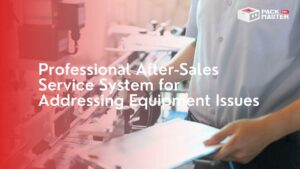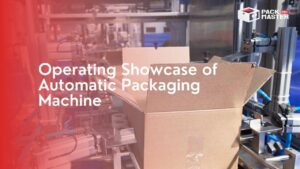What are Fully Automatic and Semi-Automatic Packing machines?
Fully Automatic Packaging Machines(FAPM)
Fully automatic packaging machines are the most advanced of the two types.
They are automated, require minimal manual intervention, and can package large batches of products at high speeds with minimal errors.
The machines typically come equipped with several features including adjustable speed settings, sensors to detect product size and shape, and robotic arms for product handling.
They can be programmed to accommodate a wide variety of shapes and sizes, allowing for efficient packaging of multiple items that require different packaging materials.
Additionally, they are highly energy efficient and have fewer components than semi-automatic machines, resulting in reduced maintenance costs.
Semi-Automatic Packaging Machines(SAPM)
In contrast to fully automatic machines, semi-automatic packaging machines are less costly and require more manual intervention.
They are designed for small to medium-sized batches of products, typically up to 500 pieces per hour. Semi-automatic machines generally have fewer features than their fully automated counterparts, such as adjustable speed settings or sensors.
However, they are still highly effective at providing efficient and accurate. However, they are still capable of producing consistent packaging results with minimal errors and require less energy to operate.
Fully automatic and semi-automatic packaging machines both offer advantages depending on the product packaging requirements.
Comparing the two types of machines is important as it can help businesses determine which type of machine is most suitable for their needs.
For example, a business needs to package large batches of products at high speeds with minimal errors. The machines typically come equipped with several features including adjustable speed settings, sensors to detect product size and shape, and robotic arms for product handling.
Maybe better off investing in a fully automatic packaging machine, whereas one that needs to package medium-sized batches with minimal errors and at a lower cost may be better suited to a semi-automatic machine.
By comparing the two types of machines, businesses can make an informed decision and select the machine that is most suitable for their needs. This will help them to achieve greater efficiency and cost savings in their packaging operations.
Fully Automatic vs Semi-Automatic
Advantages and Disadvantages of FAPM vs SAPM
Comparison Analysis of FAPM vs SAPM
Concolution
Both types of packaging machines offer advantages that must be carefully weighed before investing in either. Organizations should consider their size, budget, and production needs to determine the best option for their operations.
Additionally, skilled technicians should be available for the maintenance and repair of fully automatic machines. Ultimately, the right decision depends on each organization’s individual needs and capabilities.





